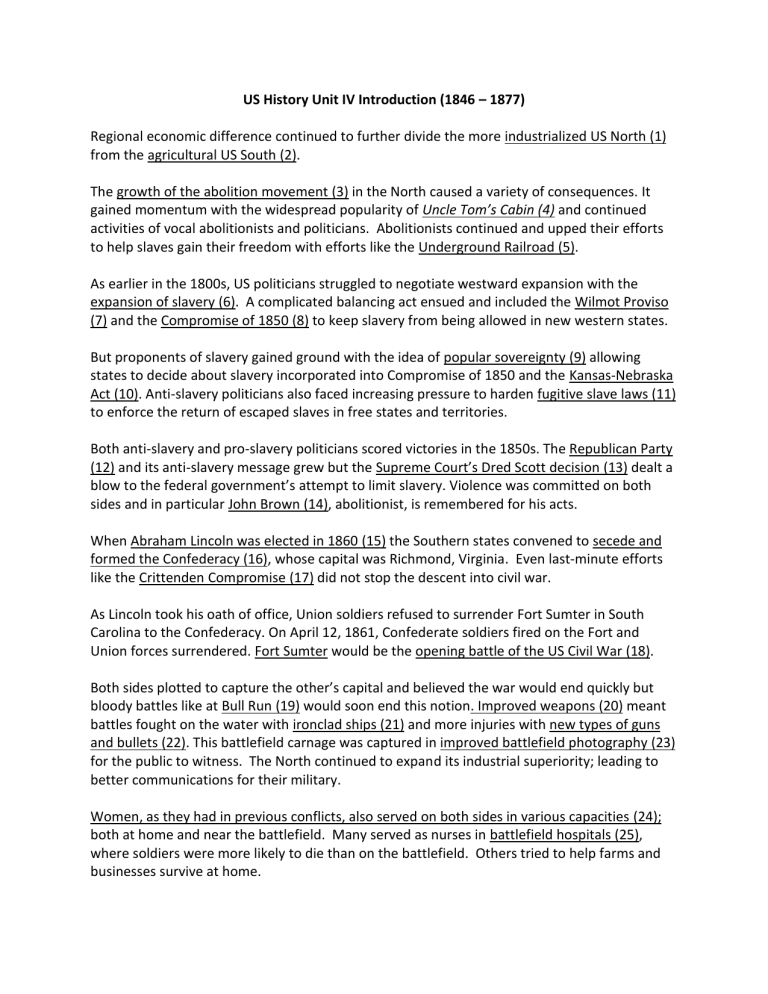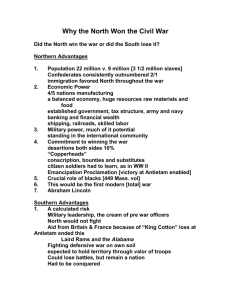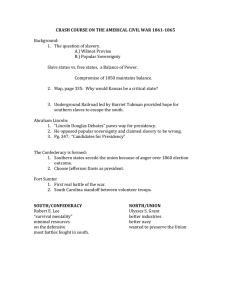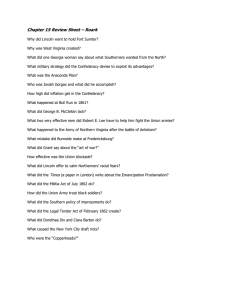
US History Unit IV Introduction (1846 – 1877) Regional economic difference continued to further divide the more industrialized US North (1) from the agricultural US South (2). The growth of the abolition movement (3) in the North caused a variety of consequences. It gained momentum with the widespread popularity of Uncle Tom’s Cabin (4) and continued activities of vocal abolitionists and politicians. Abolitionists continued and upped their efforts to help slaves gain their freedom with efforts like the Underground Railroad (5). As earlier in the 1800s, US politicians struggled to negotiate westward expansion with the expansion of slavery (6). A complicated balancing act ensued and included the Wilmot Proviso (7) and the Compromise of 1850 (8) to keep slavery from being allowed in new western states. But proponents of slavery gained ground with the idea of popular sovereignty (9) allowing states to decide about slavery incorporated into Compromise of 1850 and the Kansas-Nebraska Act (10). Anti-slavery politicians also faced increasing pressure to harden fugitive slave laws (11) to enforce the return of escaped slaves in free states and territories. Both anti-slavery and pro-slavery politicians scored victories in the 1850s. The Republican Party (12) and its anti-slavery message grew but the Supreme Court’s Dred Scott decision (13) dealt a blow to the federal government’s attempt to limit slavery. Violence was committed on both sides and in particular John Brown (14), abolitionist, is remembered for his acts. When Abraham Lincoln was elected in 1860 (15) the Southern states convened to secede and formed the Confederacy (16), whose capital was Richmond, Virginia. Even last-minute efforts like the Crittenden Compromise (17) did not stop the descent into civil war. As Lincoln took his oath of office, Union soldiers refused to surrender Fort Sumter in South Carolina to the Confederacy. On April 12, 1861, Confederate soldiers fired on the Fort and Union forces surrendered. Fort Sumter would be the opening battle of the US Civil War (18). Both sides plotted to capture the other’s capital and believed the war would end quickly but bloody battles like at Bull Run (19) would soon end this notion. Improved weapons (20) meant battles fought on the water with ironclad ships (21) and more injuries with new types of guns and bullets (22). This battlefield carnage was captured in improved battlefield photography (23) for the public to witness. The North continued to expand its industrial superiority; leading to better communications for their military. Women, as they had in previous conflicts, also served on both sides in various capacities (24); both at home and near the battlefield. Many served as nurses in battlefield hospitals (25), where soldiers were more likely to die than on the battlefield. Others tried to help farms and businesses survive at home. By July, 1862, the war was at a stalemate. Horrific battles at Antietam (26) and Fredericksburg (27) killed many on both sides without gains for either. The loss of life meant both sides had to draft soldiers (28); causing resentment and tension in both regions. To hone the moral cause to the conflict, President Lincoln issued the Emancipation Proclamation (29), which declared all slaves in the Confederacy free. The Union victories in Vicksburg (30) and Gettysburg (31) would turn the tide of the war toward a Union victory. General Sherman’s total war in Georgia (32) devastated the state. On April 9, 1865, General Lee would finally surrender to General Grant at Appomattox Court House (33) in Virginia. Positive news from the battlefield catapulted President Lincoln back into office in the election of 1864 (34) and Republicans in Congress to pass the 13th Amendment (35), abolishing slavery in the US forever. After Lee’s surrender, Lincoln would quickly introduce the idea of reconstructing the former Confederate states into the Union (36) but on April 14, 1865, President Lincoln was assassinated (37) by a Southern sympathizer. The Civil War had devastating consequences on the United States. One million died (38) and many survivors were addicted to the morphine prescribed in battlefield hospitals. The war cost $4 billion (39) for both sides while the North’s economy expanded (40) the South’s economy was completely decimated (41). Infrastructure and cities in the South had been destroyed in battle and with so many killed a majority of families were impoverished. Without the leadership of President Lincoln efforts at reconstruction of the former Confederacy floundered. President Johnson’s lenient reconstruction approach (42) led to southern states returning to their previous oppressive ways towards former slaves so Radical Reconstuctionists (43) in Congress took federal control. The Freedmen’s Bureau (44) attempted to transition the southern states to a wage economy with schools and other aid and black churches served as hosts for political and social events for newly freed slaves. It did result in more political representation but also to the rise of secret societies like the Ku Klux Klan (45) to intimidate black voters. Both the 14th Amendment (46) and 15th Amendment (47) were passed to try to further protect former enslaved persons. The 1860s and 1870s saw a country tired of trying to find ways of reconciliation and rocked with financial and political issues. But it also brought the construction of the Transcontinental Railroad (48), the redistribution of land through the Homestead Act (49), and more access to high education with the Morrell College Land Grant Act (50).



